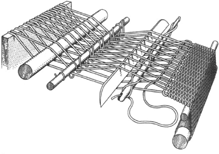
Modern fabrics … Fiber content labels, care labels, low labeling … Warp and filling jams … Thread count and its effect on durability … Plain weave, twill weave, satin weave, and other common weaves … Weft and warp knits … Jersey, garter, rib, cable, tricot, and other knits … Carded and combed yarns, staple and filament jams … Twist … Natural vs. synthetic fibers and the environment … Effect of fiber content and other factors on fabric comfort … Absorbency and permeability of fibers … Hydrophilic natural fibers and hydrophobic man-made fibers … Effect of fiber content and other factors on look, feel, resilience, durability, cleanliness, and launderability … Glossary of Fabric Terms
Most parents have had the experience of observing their child’s intense attachment to a beloved rag of a blanket or a disintegrating bit of cloth diaper. As many of them know, professional psychologists give the child’s lovey the cold-sounding name “transitional object” and explain it as an attempt to evoke maternal comfort by creating a symbol of Mother. Cloth, or something similarly soft and fuzzy, is the all but inevitable infantile symbol of a mother whose touch comes through blankets and diapers from within moments of birth. In fact, the child’s first work of art, motivated by the longing for security and affection, is this transformation of a grubby bit of cloth into something invested with the power to satisfy that longing.
In our adult lives, cloth continues to play intertwined aesthetic and functional roles. Textiles—from Oriental rugs to gleaming damasks—are the single most powerful source of domestic beauty. At the same time, they provide protection and comfort of a kind nothing else in the home can offer, shielding us and objects around us from cold, heat, dirt, damp, air, and light and from hard and rough surfaces that might bruise or scratch. The emotional warmth and security of a home, in our world, depend to a remarkable extent on the resonance of the sensations aroused by cool sheets, soft carpets, fabric-filtered light, nubby upholstery, thick towels, and so forth. By intricate chains of memory and association, these link up eventually to the primordial feelings of comfort, safety, love, and warmth that were first experienced through the medium of cloth in infancy.
All of us inevitably become textile connoisseurs. Nowadays, however, our taste is usually unconscious and inarticulate because, for a variety of historical reasons, most of us know far less about textiles than ordinary people once did. We may know what we like when we see or touch it, but we do not know what to look or ask for or how to use and care for fabrics. This diminished understanding of what so intimately concerns all of us is partly due to our increasing distance from the manufacturing, production, and care processes. But there is also far more to know than there used to be.
Until the late nineteenth century, Western people were familiar with the domestic use of four or five of the so-called natural fibers. Even in 1940, a housekeeper had to understand, by and large, the use and care of fabrics made of only six fibers: silk, linen (flax), cotton, wool, rayon (a generic name for a group of cellulosic fibers drawn from natural sources such as wood pulp), and acetate (a generic name for a group of fibers composed of cellulose acetate). By 1960 this number had more than doubled, swelled by the addition of several completely synthetic fibers. These included nylon, acrylic and modacrylic, olefin (polypropylene), and polyester. In the past few decades there has been an explosive increase in the number of processes and treatments, mechanical and chemical, to which fibers and fabrics are subjected, as manufacturers have sought not only to develop new “miracle” fabrics but to improve the appearance and function of the old ones. Endless modifications, combinations, and blends of each of the fibers are possible—for whiter whites, enhanced flame resistance, water repellancy, resistance to shrinking or pilling or static electricity buildup, environmental friendliness, and a hundred other purposes. The result is fabrics, fabric care, and cleaning requirements the identity and nature of which not even professionals can always discern by mere visual or tactile examination.
The government mandates labels that identify fiber content and provide care instructions as the solution to the problem of figuring out safe and effective care procedures. It also requires fiber content labels that specify which different fibers are contained in a garment and their percentages by weight—for example, “100% cotton” or “50% cotton, 40% polyester, 10% nylon.” (Explanations of care labels and lists of terms and symbols commonly employed on them are provided in the Glossary of Care Label Terms and Symbols on page 34.) Valuable as they are, care labels are not a perfect solution. The information given on them is exceedingly limited, even when correct, which it sometimes is not as a result of mistakes, negligence, or, occasionally, intention. “Low labeling” (when manufacturers recommend a more conservative treatment than is necessary) is common. But even when the instructions are valid, they do not tell you what rationale lies behind them, so you do not know what consequences, great or small, you risk if you use procedures different from those recommended. And many people do not really know how to read and interpret care labels. For these reasons, relying on care labels is often a frustrating business. But it is not nearly as frustrating as not having any care labels at all—a situation you will sometimes encounter with household furnishings such as tablecloths, sheets, blankets, or draperies, for which the law does not currently require care labels.
The fiber content label fills in some of the blanks that the care label leaves open. Once you learn the fiber content of the article, in theory you learn much about the nature of the fabric—whether it is durable, wrinkle-prone, stain-sresistant, hot or cool, absorbent, and so forth. In practice, however, people today are so little familiar with the properties of different fibers that to learn that a piece of upholstery or a garment is made of a cotton/synthetic blend or of acrylic in fact tells them little. And even if you understand the properties of the fiber or fibers used in the fabric, you also need to know something about the way the fabric is made and the quality of its manufacture to be sure you know how it will feel and function, how durable it will be, and how best to care for it. This chapter and the next explain the basics about fabrics. Familiarity with textile fundamentals gives you a foundation on which you can continue to increase your understanding of fibers and fabrics with each casual encounter.
The appearance, potential uses, and safe care of fabrics are determined by five factors: fiber content, yarn construction, weave or knit, dyes, and finishing and other treatments. In this chapter, I take up the first three factors in the reverse manufacturing order, first considering the weave, then unraveling the weave to consider the yarns it is composed of, and finally examining the fibers used to make the yarns. Dyes and finishing treatments, which may be applied at practically any step in the manufacturing process—on raw fiber, yarn, fabric, or even finished garments—are taken up in chapter 20.
Weaves and Knits
In woven fabrics, the yarns interlace; in knits, the yarns interloop. Woven fabrics are made on looms. The lengthwise threads on a loom are called the “warp” yarns, and the crosswise yarns are called “filling”—or “weft” or “woof”—yarns. (See the illustration below.) When weaving is done well with good-quality yarns, a pleasing, smooth, regular pattern is formed from the interlacing of the warp yarns and the filling yarns. The pattern of the weaving largely determines what type of cloth is being made—batiste, damask, oxford cloth, or corduroy. (These and many other useful terms relating to fabrics are explained in the Glossary of Fabric Terms, which begins on page 298.)
To determine the quality of the weave, hold the fabric up to the light. It should have no knots, weak spots, protruding yarns, crooked or broken yarns, or overthick yarns (slubs). The weave should be firm, close, uniform, and even.

A simple loom
Thread Count (Fabric Count). A fabric’s thread count, now called the fabric count by textile professionals, tells you just how closely woven it is. (I will use the old term because it is still widely used on packages of sheets and other household goods.) The stated thread count on packages or in catalogues helps you evaluate the nature and quality of the goods offered for sale.
A fabric may be manufactured with a tight or a loose weave. In a tight or compact weave, the yarns lie more closely together than in a loose weave. The thread count tells you just how many warp and filling yarns per square inch there are in the fabric. A thread count of 64 X 60 means that the fabric has 64 warp yarns and 60 filling yarns per square inch. The finer the yarns, the more of them can be compressed into the space of an inch; the coarser the yarns, the fewer of them go into an inch. Thus muslin sheeting made of a coarser yarn may be quite closely woven even though its thread count is less than that of percale sheeting made with a finer yarn. (“Coarse” and “fine” here refer to yarn diameter, not yarn quality.) All else being equal, closely woven cloth is stronger and more durable because it contains more yarns than a loosely woven one. A tight weave also shrinks less than a looser one and holds its shape better in laundering.
THREAD COUNT AND DURABILITY
The durability of cloth is a function of many factors besides thread count, including the weight of the cloth, the type and quality of the fibers comprising the fabric, the overall construction of the cloth and its yarns, the nature and quality of the weave, and the types of finishes used. Do not assume, therefore, that you are getting the most durable sheets or shirts when you pick those with the highest thread count. Higher thread count means greater durability only when the comparison is between similar fabrics woven with the same type of yarn. If the yarn used to produce the higher thread count is thinner and weaker, the fabric is not necessarily stronger. A satin weave is less durable than a twill, and heavier cloth wears better than lighter. Thus coarse, heavy-duty cotton fabrics used for work clothes wear longer than sateen fabric of combed Egyptian cotton and a thread count of 400 or more.
The thread count may also be expressed in one number; that is usually how it is done for sheets, pillowcases, and other household linens. The number given on the package labels is obtained by adding together the number of warp yarns and the number of filling yarns per square inch. This style of expressing the thread count is chosen because most such household items have a “balanced construction”—that is, they have roughly equal numbers of warp and filling yarns. A thread count of 220 in a balanced construction, for example, indicates that there are about 110 warp yarns and 110 filling yarns per square inch. When fabrics have an unbalanced construction (unequal numbers of warp and filling yarns)—say 100 X 60—it is more informative to see the numbers separately because the properties of balanced and unbalanced constructions are different. The yarns in a balanced construction take wear evenly, so, other things being equal, the fabric tends to wear more evenly and thus to be more durable than fabric with an unbalanced construction. But other things are not always equal. One authority gives this rule of thumb: A fabric with a high thread count but poor balance will wear better than one with a low thread count but good balance.
If you want to determine the thread count of a fabric, you can try to count the yarns yourself, but this can be difficult with high-thread-count cloth. Using a ruler and a pin (and a magnifying glass if you need to), count off the number of either filling or warp yarns in a quarter-inch square of fabric and—if it is a sheet or other fabric with a balanced construction—multiply the number by eight; you will end up with a figure that roughly represents the thread count. If it is not cloth with a balanced construction, you count both the warp and filling yarns in a quarter-inch square, and multiply each by four—say 25 X 4 and 20 X 4. You end up with the two numbers of a thread count, in this case 100 X 80.
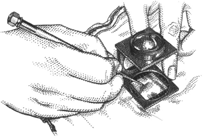
Taking a thread count (or fabric count) with a professional’s pick and magnifying glass
A fine weave of a fabric ordinarily has a better “hand”—it feels better on the hand—and is more expensive than a coarser one.
Plain Weave, Twill Weave, and Satin Weave. There are only three basic weaves, of which most other weaves are variations: plain weave, twill weave, and satin weave. They vary in the way the lengthwise (warp) yarns are crossed by the filling (weft) yarns. Each of them can be found in looser and tighter and in coarser and finer versions, made of virtually any type of fiber or blend of fibers.
In plain weave, each filling yarn alternates over and under successive warp yarns across the fabric, and on its return across the fabric the filling yarn goes under and over alternate warp yarns. Plain weave appears identical on both sides and has no right side or wrong side unless it is napped or printed or otherwise finished differently on one side. Plain weave is used in dozens of fabric types, including broadcloth, calico, cambric, challis, percale, seersucker, blanket cloth, and tweed. Most sheets are plain weave. (But there are also sateen and twill-weave sheets as well as knitted-fabric sheets.) Plain-weave fabrics will generally be quite durable when the thread count is high. They may wrinkle more than twills.
There are several variations on the plain weave, of which the most common are the basket weave and ribbed or corded weaves. The basket weave creates fabrics that are usually loosely woven. It is often used for draperies and other furnishings because it hangs well. It is also somewhat wrinkle-resistant and flexible. It is not particularly durable, however, because it is of loose construction and contains yarns with little twist. Thus it is less suitable for many kinds of clothing than a balanced plain weave. Ribbed or corded fabrics (such as poplin, taffeta, faille, or ottoman) are created by using double the number of warp yarns as filling yarns, with larger filling than warp yarns; they are less durable than balanced plain-woven fabrics because of the increased abrasion to which the raised cords or ribs are exposed.
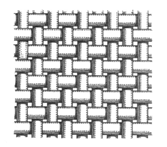
Plain weave: Each filling yarn goes over and under each warp yarn, making a pattern of squares
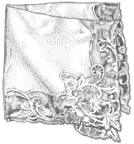
Plain-weave handkerchief with lace trim
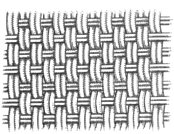
Basket weave: Two warp yarns pass over and under two filling yarns
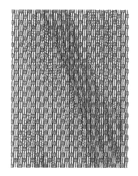
Fabric woven in basket weave
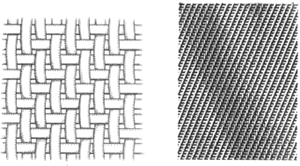
Twill weave: One or more warp (or filling) yarns go over at least two filling (or warp) yarns. The next warp (or filling) yarn(s) do not go over the same yarns as their neighbors. Instead the point of intersection is moved up or down by one or more yarns, creating the characteristic diagonal in the twill weave.
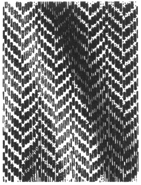
Herringbone twill
The twill weave has a characteristic diagonal pattern that can be varied to form attractive patterns by changing the direction of the diagonal, as in the herringbone weave. When the diagonal is more prominent on one side than the other, this side will be the face of the twill. A twill weave is more durable than a comparable plain-woven fabric; usually the steeper the diagonal of the twill line, the greater its strength and durability. Suits and coats are often made of fabrics in a twill weave. The long-favored denim, famous for its hardiness, is also a twill weave, as are gabardine, foulard, many tweeds, and serge. While twill fabrics are not perfectly wrinkle-resistant, they are more resistant to wrinkling than are plain-woven fabrics.
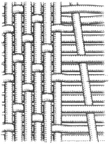
Satin weave: The warp yarns float over two or more filling yarns, creating a smooth, lustrous surface.
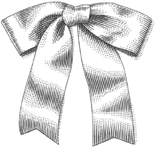
Satin weave fabric
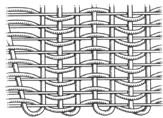
Gauze weave used in marquisette
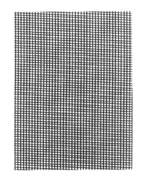
Marquisette
A satin weave tends to be less durable than plain and twill weaves because the yarns are given less twist—in order to make the fabric smoother and more lustrous—and because the long floating yarns on the fabric surface are more subject to snag and wear. (Floats are the length of the warp between the filling yarns.) Satin weave, however, is valued for this smooth, lustrous surface, which is desirable for elegant clothes. The shiny side of the satin weave is its face. Satin weaves also drape well. They are warmer and more absorbent because they are compact weaves: a great amount of fine yarn is woven into a small space. This gives satin weaves high thread counts despite their lower durability.
Other Common Weaves. Besides the three basic weaves, there are a few others with which it is useful to be familiar.
Double-woven cloth is usually chosen for its greater warmth and body. Double-woven cloth is made on a loom capable of simultaneously weaving two layers of fabric and joining the layers so as to create a single fabric. Doublewoven fabrics may have different weaves on their two sides—for example, plain weave on one side and twill on the other. Many double-woven fabrics are reversible.
Leno weave is done on a loom capable of crossing two adjacent warp yarns. It is used to make lightweight, open-mesh fabrics, such as marquisette. This weave is also called gauze weave.
Dotted swiss cloth is a familiar example of a fabric created by swivel weaving, in which decorations such as circles or dots are woven into the surface of the cloth. Swivel weaves create the same design on both sides of the cloth. These fabrics typically are delicate enough that rough treatment in the laundry or elsewhere can pull the decorations out. Similar decorations are produced by lappet weaving, a method in which additional warp yarns are used to create small designs that are not the same on both sides of the cloth. Lappet-woven fabrics tend to be more durable than swivel-woven fabrics because the ends of the decoration threads are more securely fastened.
The dobby weave creates simple designs by means of a mechanical attachment to a plain loom. Bird’s-eye is the name of a typical fabric having dobby weave. The jacquard weave creates fabrics with highly intricate designs. Jacquard weaving is done on a jacquard loom, which uses punched cards that control the movements of the warp yarns. This intricate type of weaving is used to make fine linen damasks, upholstery fabrics, silk brocades, and tapestries.
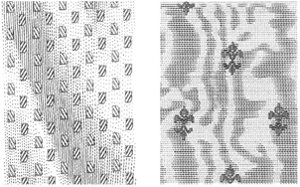
Two dobby-weave fabrics: The right-hand sample shows a dobby-weave fabric with a moiré.
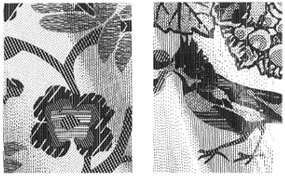
Two jacquard-weave fabrics
Many weaves that were associated entirely with one sort of fiber a hundred years ago are now often available in virtually any sort of fiber one might wish. Serge, for example, once meant a very strong worsted (that is, a fabric of combed wool fibers) in a twill weave. Now serge may be made of wool, rayon, silk, or other fibers, and “worsted” refers to any type of yarn spun of longer, smoother, stronger yarns. Velvet originally meant a fabric made of silk, but now the word refers to any pile fabric with a plain or twill back and warp yarns forming the pile—silk, rayon, nylon, cotton, or synthetic. Flannel was once a wool fabric, but it is now more typically made of cotton and may be any napped, soft, loosely woven cloth of either plain or twill weave.
Knits. Knitted fabrics have characteristics unlike those of woven ones. Although woven ones, in general, hold their shape better, knitted ones tend to drape better and be less susceptible to wrinkling. By and large, knits deserve their reputation for being good travel choices. Knitted fabrics are usually more stretchy or elastic than woven fabrics and thus are famous for fit and comfort. But, because they are stretchy, they may bag, sag, or lose their shape if not well constructed. Knits are particularly prone to pilling and snagging because of their loose construction and the low twist of their yarns. Unless treated, knits, especially those made from cotton, have a strong propensity to shrink. Synthetic fibers are often used in knits, exclusively or in blends with natural fibers, to resolve such problems. When made of absorbent fibers, knits are exceptionally absorbent. They are highly air-permeable, and for that reason they are not good wind breakers. They are ideal for cool weather when they are thick and made from fuzzy, crimped fibers such as wool. Such knitted fabrics trap warm air near the skin very effectively. On the other hand, thin knits such as cotton T-shirts are especially comfortable for warm-weather wear.
Commercial knitwear is made by one of two processes: weft knitting or warp knitting. Weft knitting, like hand knitting, creates fabric by moving yarns horizontally back and forth across the fabric. Weft knitting permits rapid changes of design, but weft knits will run and unravel if a loop gets broken. Warp knitting creates fabrics in which the yarns run vertically in the fabric. Warp knits have less stretch than weft but will not run or unravel.
Weft Knits. Plain knit, also called jersey, is the basic knit stitch. (This is called stockinet when you do it at home by hand, knitting alternating rows of knit and purl stitches.) Jersey fabrics stretch both lengthwise and width wise, but considerably more in the width. They are smooth on the right side (unless made with nubby yarns), showing vertical rows of Vs, and slightly nubby on the wrong side. They are commonly used for T-shirts, men’s underwear, sweaters, socks, gloves, and other apparel. Jersey knits will unravel at the ends and form runs, too. Unless steps are taken to prevent it, they tend to curl up crosswise, or across the width, toward the face of the fabric and lengthwise toward the back side of the fabric. The more stitches per inch, the better a jersey knit holds its shape.
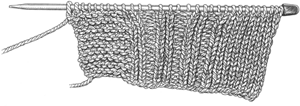
Front side of hand-knitted sampler: From left to right, plain knitting (or garter stitch), rib knit, and stockinet

Reverse side of knitted sampler: From left to right, stockinet, rib knit, and plain knitting
Links-links, or purl knit, looks like the fabric a home knitter creates doing garter stitch (knitting entirely in knit stitch or purl stitch), or plain knitting. It looks the same on front and back. Raised rows alternate with indented rows, which are only clearly visible if you stretch the material lengthwise. It is often used for babies’ and children’s clothes because it stretches both lengthwise and widthwise, but more in the length. Purl fabric is also commonly used for sweaters and other apparel. Like jersey knits, it unravels at both ends and can develop runs.
A rib knit produces alternating raised and indented rows (“ribs”), each consisting entirely of knit or purl stitches. In rib knits, the ribs run vertically and the stretch comes from their crosswise extension. (In hand knitting you make ribs by alternating a fixed number of knit and purl stitches, creating alternating columns of stockinet and garter stitch.) Because rib knit stretches more in the width than in the length, it is good for waists and wristbands in sweaters: it will stretch to allow you to put on the garment and then contract to fit your wrist or waist snugly. Rib knit is also used for the bodies of close-fitting sweaters and hats. Some ribs do, and some do not, look the same front and back.
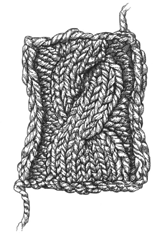
Cable stitch
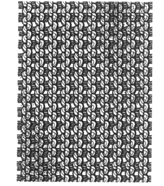
Raschel knit fabric
Cable stitch is used to make the plaited, interweaving decorative columns that appear on many sweaters and afghans.
Double knits are rib knits with two layers of loops. They are similar to double-woven fabrics. They are produced on knitting machines that have two sets of needles working simultaneously. The fabrics produced have a firmness and stability of shape that is comparable to that of woven fabrics. At the same time, double knits, like all knits, are naturally wrinkle-resistant. Double knits are used for women’s suits and dresses, some menswear, and much sportswear.
Warp Knits. Tricot knits are the most common type of warp knit. They are produced on the tricot knitting machine, which can use very fine yarns such as those used to make lingerie fabrics. It can also produce a wide range of designs but does not easily permit changes of design or complex designs. Tricot knits look like rows of chains on the right side and rows of Vs or zigzags on the back (reverse) side. (You might need a magnifying glass to see this.)
Tricot fabrics drape well, are soft, have good wrinkle-resistance, and are elastic and strong. They are also open enough that air and moisture can pass through, promoting comfort.
Raschel fabrics are the second main type of warp knit. They are produced on the raschel knitting machine, which permits more versatility and complexity in design patterns and quicker change in design than tricot machines. The raschel knitting machine, for example, can produce heavy blankets, bedspreads, carpets, pile fabrics, fine laces, and veils, using any type of fiber whatsoever.
Both tricot and raschel knitting machines are used to make elasticized fabrics and waistbands, swimsuits, stretch foundation garments, and the like.
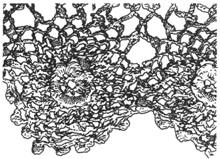
Handmade lace
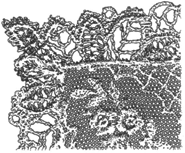
Machine-made lace
Lace. Lace is an openwork fabric of yarns that are twisted, looped, braided, stitched, or knotted together to form patterns. Although handmade lace is still produced for sale, almost all lace today is machine-made (usually on warp knitting machines). Machine-made lace is usually much less expensive and much more durable than handmade lace. Any lace pattern that can be produced by hand can also be produced by machine. Most patterns produced by machine today can be found in design anthologies that feature lace patterns owned by kings and queens centuries ago.
By its nature, lace tends to be delicate and easy to tear. Handmade lace should generally receive exceedingly gentle care. Laces can sometimes be machine-washed but often require hand-washing. The proper care of lace, like other fabrics, depends on the type of fiber of which it is made. Cotton, linen, silk, rayon, polyester, and other fibers are all commonly used for making lace today.
Yarn Construction
Carded and Combed; Staple and Filament Yarns. In the case of wool and cotton, the process of spinning raw natural fibers into yarns begins with carding or combing the fibers. Carded fibers are arranged in parallel fashion by a carding machine. The ropelike structure formed is called sliver; it can be spun to form carded yarn. Combing is a process in which the sliver is carded again, rendering the fibers more parallel to each other and removing the shorter fibers. Yarn made from combed fibers is called combed yarn. Combed yarns, of whatever fiber, produce superior fabrics that are stronger and smoother than those made of carded yarns. Articles made of combed cotton yarns, therefore, are so identified on labels to enable the buyer to know that they are of higher quality. Fuzzier woolen yarns are made from carded yarns; wool worsted, a smoother type of wool fabric, is made from combed yarns. See chapter 21, “The Natural Fibers.” Linen yarns, too, are spun out of both short-staple fibers, called tow, and long-staple fibers, called line. Fine linen articles are always of line.
Silk is the only natural fiber that comes in filament lengths—that is, very long strands of up to a couple of thousand feet—as well as short (staple) lengths produced as waste in the process of reeling the long silk from cocoons. Whereas the staple-length silk fibers are spun into yarns the same way that cotton is, reeled silk filaments are twisted together in a process called throwing.
Synthetic fibers may be manufactured as staple that will be spun into yarns like cotton or wool fibers or as filaments of indefinite length that will be thrown like silk filaments. Rayon exists in both staple and filament forms, but it is mostly used in staple form.
Filament (or thrown) yarn may have strikingly different properties from spun yarn of the same fiber. For example, spun nylon would be used for sweaters and blankets, but filament nylon is necessary for silky lingerie and undergarments. Spun silk is less lustrous, strong, and elastic than thrown silk and tends to become fuzzy in use because the staple fibers rub up. Generally speaking, fabrics of spun yarn usually have a better hand and are fuzzier and softer, less smooth or slick, less lustrous, more adsorbent (because of a greater surface area—see page 294), more water-vapor permeable, warmer, and more insulating; they trap dirt more easily, produce more lint, pill more, slip less when you are sewing with them, and snag less than filament yarns of the same fiber and size.
Filament yarns, in turn, can be manufactured in different forms that result in fabrics of widely varying properties. Synthetic “textured” filament yarns (made of filament fibers that do not he straight, close, and parallel) give greater comfort than older types of synthetic fabrics, which were made of flat multifilament yarns (made of straight filaments that pack close together and lie straight and parallel to one another). Thus, newer textured yarn fabrics do not lie so flat on the skin and do not feel as hot and clammy as flat yarn fabrics. They let more water vapor and air pass through, have greater adsorbency, and, in general, feel more comfortable. They also have a better hand, one more similar to that of spun yarns. Today, most clothing fabric made of synthetic fibers uses textured yarns.
Twist. In all types of yarn, the tightness of the twist in the yarn has a major effect on the characteristics of the finished fabric. Fabrics of harder-twisted yarns, other things being equal, are stronger, smoother, more elastic, more resilient, more abrasion-resistant, more absorbent and adsorbent, less prone to pilling or snagging, and even more comfortable on the skin. Up to a point, hard-twisted yarn also tends to shrink less, but both very low-twist and very high-twist yarns will shrink more—sometimes much more—than yarns with a moderate to high twist. Extremely hard-twisted yarns may also begin to weaken from the stress of the twist. Very fine, hard-twisted yarns are used for sheer fabrics, such as georgette, chiffon, and voile. Soft-twisted yarns are necessary for soft woolen fabrics. Crêpe fabrics are created when hard-twisted yarns with both right-hand and left-hand twists are woven into the fabric. When the fabric gets wet, the yarns kink in different directions, producing the crêpey look. Many other effects can be created by using different twists, both hard and soft.
Fiber Content
The strongest determinant of a fabric’s properties is the type or types of fiber of which it is made. A fabric’s coolness or warmth, durability, strength, washability, dry-cleanability, absorbency, cleanliness, softness, smoothness, resilience (proneness to wrinkling), hand, and many other properties, as well as its cost, are affected as much or more by the fibers it is made of than by construction, weave, finish, dye, or any other single factor. How you clean and care for garments and furnishings is affected more by fiber content than by any other factor. (Chapters 21 and 22 give details on the characteristics and care of each type of fiber commonly used in clothing and furnishings in the home.)
Natural Versus Synthetic Fibers. Some people insist on using only “natural” fibers, but “natural” is a term of doubtful meaning in this context as in so many others. Applied to fabrics, it denotes fibers of plant or animal origin, such as cotton, linen (flax), silk, or wool. These, the major natural fibers, are derived, respectively, from the downy coverings of the seeds of cotton plants, the stalks of flax plants, silkworms’ cocoons, and sheep’s wool. Other fairly common plant, or “cellulosic,” fibers used to make clothes and household furnishings are jute, hemp, and ramie. All other fibers, such as rayon, nylon, polyester, acetate, acrylic, and spandex, are termed “synthetic,” “man-made,” or “manufactured.” But the distinction between natural and synthetic fibers is somewhat strained. The plant and animal substances from which the “natural” fibers are derived are indeed naturally occuring, but wood pulp, coal, and petroleum products are provided by Mother Nature, just as flax and cotton are. Flax and cotton, moreover, are subjected to repeated mechanical and chemical treatments that alter their appearance, shape, color, and other qualities. When we refer to the products of these enormously complicated manufacturing chains as “natural” and regard nylon as “synthetic,” we are saying more about our own preferences for the familiar and the traditional than about the characteristics of the cloth.
This is not to say that preferences for natural fibers are necessarily arbitrary. Natural fibers have characteristics that really make them, in many instances, the best choice for furnishings and clothing, especially clothing to be worn next to the skin. For one, they are all hydrophilic (water-loving or -attracting), whereas most manufactured fibers (except for rayon, a cellulose-based fiber, and its cousins) are hydrophobic (water-hating or -repelling). This is what makes the natural fibers more absorbent, which is, as we shall see, a prime factor in their superior comfort under many circumstances. But by and large, the best choice of fiber for a particular function cannot be based on the thin distinction between natural and synthetic. A synthetic carpet backing that is rot-proof is preferable to a jute one that is not. A drape made of light-resistant synthetic fibers will last much longer and cost less than a silk one that will all too soon fall to pieces from the effects of ultraviolet radiation; the synthetic might even look as good. But the prejudice against synthetics is not easily removed because it has been infected with status perceptions. Wrongly but persistently, synthetics are associated with bright, unfading colors, smoothness, neat creases, durability, and cheapness, and they are disdained. Meanwhile clothes that wrinkle, fade, shrink, bleed, and develop holes become signs of superior taste and class, and deeper pockets, as these characteristics, equally mistakenly, are identified as the attributes of “natural” fibers such as cotton.
Sometimes the prejudice goes the other way, too, in favor of synthetics when they make little sense. People may sometimes choose synthetics for certain types of exercise and sportswear only because they feel that shiny, stretchy, “high-tech” fabrics are the right fashion statement for the exercise club, or because the symbolic value of synthetics rises in the sports world. Predictably, too, when natural fibers are chosen out of a sense of moral superiority, a backlash in favor of fun and self-indulgence cannot be long in coming, and this, as well, partly explains certain trends in favor of synthetic fibers where they are not necessarily better. The production of newer, high-priced, luxury versions of older synthetics is another development that has probably done more than anything else to erode prejudice against synthetics.
Environmental concerns have tended to push people toward buying natural fibers, but the facts do not present us with a clear-cut choice for one or the other on environmental grounds. Environmental issues in the textile industry are exceedingly complex. You must weigh not only the effects of elaborate agricultural, production, and manufacturing processes, but also the finishes and dyes that are likely to be used on both sides; the number of years the two kinds of fabrics are likely to survive; whether they are likely to be dry-cleaned or laundered, how they will be laundered, and the relative advantages and disadvantages of those processes environmentally; any waste or disposal problems created by a particular fiber; whether the fabric will be recyclable; and what reforms are ultimately possible in each case. There are studies that suggest that cloth makes its biggest impact on the environment not during the manufacturing process but while we own it, as a result of dry cleaning and laundering.
Most synthetics are made of petroleum products, a nonrenewable resource. Natural fibers are made of renewable resources. But the agricultural and manufacturing processes that produce cotton, for example, create staggering amounts of pollution in the form of pesticides (common estimates are that from 25 to 50 percent of the world’s pesticides are devoted to cotton crops); defoliants and other herbicides; fungicides; chemical fertilizers such as nitrates; enormous poundages of bleach, softeners and fading agents, and sizing agents such as polyvinyl acetate; resins, including polyurethane resin, acrylic, and formaldehyde resins; dyes (the excess goes down the drain and, unless biodegradable passes into the soil and surface water); and the large quantities of energy and water needed to carry out these processes. Pollution from these substances affects the earth, water, and air. Similar concerns have been raised about other natural fibers, although the problems associated with silk, wool, and linen appear to be smaller, in part because smaller quantities of such fibers are produced. Sheep for wool require millions of acres of land for grazing and sheep dips containing phosphorus or chlorine. Chromium mordant dyes used on wool in underdeveloped countries can create toxic sludge.*
Industry and government have not been indifferent to these environmental problems. Reforms have been instituted, and more are likely to come, both formally, through environmental regulations, and informally, both through manufacturers’ attempts to clean up their production processes and the production of “transitional,” “green,” and organic cottons. “Transitional” cottons are those grown without pesticides but on soil that has not been clear of pesticides and chemicals long enough to qualify as organic. “Green” cottons are not organic—that is, they have been grown with pesticides and chemicals—but they are “minimally processed”: they may have used low-impact or non-toxic dyes or closed-system dyeing; they may be unbleached or undyed; they may be stonewashed (which is considered environmentally better than using chemical softeners) or enzyme-softened (which may be better than both). Preshrinking may be done by washing, with no chemicals; starch may be used rather than polyvinyl acetate. There are even naturally colored cotton fibers—mostly in green and brown—that require no dyeing.
Some environmentalists favor the increased use of hemp for fabrics because it can be grown without pesticides, fertilizers, and other chemicals required for cotton growing. Unfortunately, laws in this country make it difficult to be a legal hemp grower because of hemp’s great similarity to the marijuana plant, which is illegal to grow. The type of hemp plant used in textiles is a different strain, however, and cannot be used for drugs. In many states, laws to make it easier to grow this type of hemp have been proposed in recent years. The push to grow more hemp has also coincided with a push toward developing better and more attractive types of hemp fabrics. These have been given some attention by clothes designers in recent years, and the number of imported hemp garments on sale in the United States appears to have increased considerably.
Because the manufacture of viscose rayon (which constitutes 95 percent of the rayon currently marketed) has always been a highly polluting process, the pressure of environmentalism has led to the introduction of a new rayon fiber, brand name Tencel and generic name lyocell, that is now being promoted as environmentally favorable or low-impact. Like all rayon, lyocell is made of cellulosic polymers derived from wood pulp, which is a renewable resource that uses little fertilizer or pesticides. But lyocell is said to be taken from sustainably harvested tree farms; and, unlike conventional rayon, it is made in a solvent spinning process that is “close-looped,” meaning that the dissolving agent is used over and over rather than being discarded as waste with each batch. The Achilles’ heel of this product, as with all rayon, is the pulp-making process, which releases massive amounts of natural and unnatural chemicals into the environment.
Other attempts to make natural fibers available without harmful pollution include various kinds of recycling. Wool has always been recycled (see chapter 21). Cottons, however, have not been; only recently have some companies begun shredding and respinning cotton fabrics into yarns by relatively clean processes.
It is difficult to find any objective evaluation of the effects of all this. The environmental regulations are said to have brought about real improvements. But none of the organic or low-impact fibers so far constitutes a significant share of the market. (Of about 13.5 million acres of cotton planted in the United States in 2003, only about 4,000—less than .03 percent—were dedicated to organic and transition cotton.)* They cost considerably more than conventional cottons and rayon. Unless a product is labeled to show that it is both organically grown and processed, moreover, the buyer often does not know which improved procedures were actually used. All of these products and procedures offer real benefits, or at least could make a real difference if they amounted to somewhat more than a small drop in a large bucket. Alas, the sacrifice required on the part of a buyer determined to purchase only environmentally virtuous natural-fiber products, in terms of variety, cost, and quality, is still immense.
Spokespeople for synthetic fiber manufacturers argue, with some justice, that the production of low-impact cotton and even expensive organic cotton has a greater negative environmental impact than polyester production, both because of the enormous amounts of water and energy that cotton growing consumes and because the manufacture of even these virtuous products typically creates chemical pollutants as by-products. They point out that the manufacture of synthetics involves no growing or raising process to complicate matters, and synthetic fiber manufacturing continually reuses solvents rather than discarding them as waste. Dyeing synthetic fibers (other than acrylics) does not require prior bleaching, which uses massive amounts of water to prepare the fibers; synthetic fibers are already white. Although there are as yet no efforts toward recycling synthetic textiles (and these are unlikely anytime soon because of the complications presented by textiles made of blended fibers), plastic beverage bottles have been recycled and used to manufacture synthetic fabrics that are made into outerwear. In 2002, the FTC recognized a new synthetic fiber that, like lyocell, was designed to be more environmentally favorable than its predecessors. This fiber, called PLA and trade-named Ingeo, is in some respects like polyester but, unlike polyester, uses plant sources, such as corn and sugarbeets, for raw material where polyester relies on petrochemical sources. PLA is also said to be compostible in industrial composts. See pages 362-63. So far, PLA is available in few goods for the home.
Those who wish to fight pollution with their textile-buying habits might sensibly try buying goods manufactured only in countries with expensive pollution-control regulations—our own, many Western European countries, Canada, Australia, and Japan. Many other Asian, African, and Central and South American countries do not have such laws. Avoiding overfrequent laundering and dry cleaning of clothes and furnishings is environmentally prudent too. But perhaps the surest bet of all, at least for the time being, may simply be not to buy so much. (An academic specialist in textiles told me that the annual rate of consumption of textiles is about 40 kilograms per person in the United States, 20 kilograms per person in Europe, and 2 to 3 kilograms per person in Asia.) This would mean buying things that last longer and learning how to clean, preserve, and mend them so as to extend their lives. So far there has been no call for the really revolutionary solution: an end to fashion, the pleasant habit that keeps most of us buying new clothes and furnishings when old ones are quite serviceable.
Effect of Fiber Content on Fabric Performance; Interplay with Other Determinants
Comfort Is Partly Subjective. Fiber content strongly affects how comfortable a fabric feels. Some types of polyester now have a pleasing silky or cottony hand, but older types had a slight harshness, and many types still do. Wool can be scratchy. Coarse weaves of many fibers are literally painful when worn against the skin. Medieval penitents who donned coarse sackcloth undershirts chose an effective means of self-torment.
Some scientific bases for the comfort factor of various kinds of fabrics are discussed below, but the reader should remember that the final test is in the wearing. If you find a fabric comfortable (or not), that is all that counts. Comfort depends not only on the characteristics of the fabric but on those of the wearer—how much you perspire, your skin sensitivity, your bodily responses to environmental factors, and so forth. In addition, some places on the body are more sensitive, warmer, or cooler than others; and some people’s bodies are overall more sensitive, warmer, and cooler than others’. Dressing for comfort means juggling a lot of subjective factors with the objective ones.
Comfort Effects of Absorbency and Permeability of Fibers; Dressing for the Weather. A fabric’s comfort in different kinds of weather depends largely on the extent to which it is permeable to air and water vapor. In fact, the interactions of skin, perspiration, air, fabrics, and environmental heat and moisture are so complicated that scientists only now feel they are beginning to unravel their mysteries, which would require whole books to explain thoroughly.
At temperatures around 85°F, so textile scientists tell us, the amount of heat produced by the human body and the amount lost to the environment are in equilibrium, and you will feel warm enough without clothes. Although the naked body can accommodate cooler temperatures to some extent by contracting its blood capillaries or shivering, it will start feeling chilly and uncomfortable at temperatures only a little lower; you will begin to want something on. At slightly higher temperatures, the body dilates the capillaries and sweats to cool itself; you may find yourself wanting to remove layers of clothing. But although wet skin is less comfortable than dry, it does not follow that in very warm weather no clothing is more comfortable than light clothing. Clothing can cool you down and protect you from the heat of the sun.
Whether a fabric holds heat well or poorly is a profound determinant of the comfort it affords. Relatively recently, people thought that the comparative warmth or coolness of different fabrics was mostly a function of how well, comparatively, their fibers conducted heat. I was taught as a girl that it was because linen was a good heat conductor (it conducted heat away from the body) that it was cool, and that wool was warm because it was a poor heat conductor (it did not conduct heat away from the body). This was not accurate.
In fact, all textile fibers are rather poor heat conductors, and fabrics can be excellent insulators. Metals will conduct heat a thousand times better. But the air warmed by your body is trapped by the textile material. Woven textiles, being nothing more than a latticework of air and textile fibers, thus create an extremely effective and lightweight insulation, holding heat near your body and preventing it from being lost to the wind or the surrounding cooler air. The thicker a fabric and the more air pockets it has, the better it holds heat. (Note that a thick fabric may or may not also be heavy.) The coolest fabrics, therefore, are the thinnest, smoothest, most loosely constructed ones, for these are least effective in holding a layer of warmed air around you. Napped, pile, and fuzzy fabrics, of whatever fiber, tend to be warmer than smooth ones because they hold air in the interstices between the fibers that make up the fuzz. Linen (flax), whose fibers are extremely smooth and are readily woven into very fine and air-permeable fabrics that are nonetheless strong, is thus highly valued as summer wear. Flannel sheets, which have a fuzzy surface that traps air, feel warmer than regular sheets. Wool fibers, which are even fuzzier and are scaly and quite crimped, trap a great deal of air and thus make an extremely warm fabric. Yet because wool worsteds that are smooth and fine can be woven, there are summer-weight wools too (although they could never compete with linen for coolness). Silk is often warm, but it is usually considered summery because it can be woven into lightweight and highly breathable fabrics—fabrics that permit air to pass in and out. Even linen yarns can be knitted into a rather spongy, dense material fit for cooler weather. Thus, although fiber content is quite important to how cool or warm a fabric is, it is by no means the whole story.
The way a fabric reacts to moisture is almost as important as the way it holds heat in determining whether people feel that it is comfortable. A complicated interplay occurs among the effects of moisture, air and other factors, and fabrics. The comfort goal in moisture management is to keep your skin neither too wet nor too dry. Dry skin feels scratchy, and it itches. Wet skin is uncomfortable too. Fabric acts on it more abrasively; it is more vulnerable to infections from funguses or other microorganisms; if your feet are sweating you are more likely to get blisters. Your skin naturally and constantly loses moisture—through perspiration—even when it feels perfectly dry. In a hot environment, you will notice when you begin to sweat. You feel cooler when the perspiration evaporates from your skin. Usually what you want your clothing to do is let your perspiration move away from your body; usually, therefore, absorbent fabrics are far more comfortable against the skin than unabsorbent ones.
The so-called natural fibers (cotton, linen, silk, wool, ramie, hemp) and the cellulosic man-made fibers (rayon and lyocell) are all absorbent and hydrophilic or water-attracting. Synthetic fibers such as polyester, nylon, acrylic, and polypropylene are all unabsorbent and hydrophobic or water-repelling. When an absorbent fabric is placed on your skin, water evaporating from your skin surface will be taken right into its fibers. Highly absorbent fabrics can often hold great quantities of moisture before they become saturated; thus they can keep you quite comfortable unless you perspire a great deal. When the fibers and the air trapped in and near their interstices all begin to fill with moisture, the insulating ability of the fabric will be decreased, and you may also start to feel cooler. As the saturation point of the fabric is reached, for example, on a very hot day when you are exercising actively, your skin may begin to feel wet again. If a fabric releases absorbed water readily through evaporation, it is less likely to become or stay saturated and it is likely to remain more comfortable. How readily the moisture evaporates from the fabric depends only partly on fiber content; fabric and yarn construction and garment construction are also extremely important, as are the environmental temperature and humidity. Wool, by the way, has extraordinary advantages in cold, damp weather. Not only does it take in enormous quantities of moisture before becoming saturated, it actually releases enough heat as it becomes wet to help you feel warm.
Fabrics also remove moisture from the skin by mechanisms other than absorbency. Synthetic fibers as well as natural ones, for example, may adsorb or wick. (The latter term, still absent from many dictionaries, gradually worked its way from textile-industry jargon into advertisements for the public.) “Adsorbency” refers to a fabric’s capacity to attract water to its surface. The more surface area a cloth has, the more water it can hold on its surface, which partly explains the longer drying time for cotton towels with looped-fiber surfaces compared to those with cut pile (velour)—the former simply have a greater surface area to adhere to. When fabrics “wick” moisture, they draw it off the skin surface and pass it along their interstices (without absorbing it), where it evaporates into the air at a rate determined by fiber type, the atmospheric relative humidity, and other factors. If you put the edge of a cotton towel in water, you can watch the water wick up the cloth.
Such hydrophilic fibers as cotton, linen, and rayon tend to hold moisture longer than the hydrophobic ones such as nylon, polyester, and polypropylene, which dry more readily; this slight dampness contributes to their keeping you feeling cool in warm weather. On a hot summer day, you will love the coolness—hence the ever-popular cotton T-shirt for a summers jog. It’s better than bare. But if you are cross-country skiing on a frigid day and sweat to the point of soaking your cotton undershirt, you put yourself at risk for dangerous hypothermia. That is why sports experts often recommend that for cold-weather sports you wear a wicking type of fiber next to the skin—to get perspiration off the skin and let it evaporate rather than saturate the fabric. Not all synthetic fabrics wick, however, or wick sufficiently to make you comfortable in the extremes of cold weather or warm, humid weather, particularly when you are exercising heavily. And not all forms of exercise produce enough perspiration to make high wickability the chief desideratum of next-to-skin clothing. Wearing ordinary polyester, nylon, or other synthetics in the summer can make you feel hot and clammy or itchy. Among synthetics, polypropylene naturally wicks well. Some synthetics are constructed so as to wick well; the fibers in one type are actually hollow tubes through which perspiration can pass. There are also finishes applied to synthetic fabrics that promote wicking.
A fabric’s “breathability,” as the retailers call it, really refers to its permeability to water vapor; this is another factor that strongly affects comfort. Various coatings applied for waterproofing, for example, render fabrics impermeable to water vapor in the way that vinyl upholstery or rubber and plastic are impermeable. As your perspiration evaporates, it cannot pass through such fabrics into the surrounding air; you feel wet and uncomfortable. The hotter it is, the more water-vapor permeability you will want in your clothes and the less you will enjoy sitting on a vinyl car seat or upholstery that is completely impermeable. The most comfortable rain gear is impermeable to moisture from the outside but permits water vapor from the inside to pass through, so you do not become wet from your own perspiration. Fabrics such as Gore-Tex are designed to do this.
Garment construction also matters greatly to your comfort. Never underestimate the simple effect of unbuttoning your coat or of loose or vented clothing that lets air in. Unzipping can be far more effective than wicking. Close-fitting garments are warmer than loose ones just because they do not let the air inside them move around much. Tight cuffs and collars and waists also keep the air in and restrict its flow. Double-breasted garments insulate better than single-breasted ones. Unbuttoning your collar, loosening your tie, removing your scarf, taking off one insulating layer—all are actions that can overpower the effects of fiber content and construction. On the other hand, no amount of loosening and unbuttoning is going to make your Norwegian wool sweater endurable on the beach in August.
Aesthetics: Look and Feel. In the world of textiles, a fabric’s “hand” refers only to its feel on the hand, not to its feel on other parts of the body and not to its feel, in general, on the skin. In fact, your hands and other parts of you can respond quite differently to the same fabric, which explains why the sheet or shirt that feels so lovely when you handle it in the store can give quite an ugly sensation when pressed against your back. To say that a fabric has a good hand is a purely aesthetic evaluation. Yet the fabric’s hand contributes significantly to its comfort.
Fiber content strongly affects how smooth, rough, silky, soft, hard, or luxurious a fabric feels. The satiny feel of some silks can never be matched by wools, no matter how finely woven. Many 100 percent polyesters lack the pleasant sensations of linen and cotton on the skin. The softness of good wool cannot be achieved with cotton or linen. Each of the major fibers, as rendered in an ordinary plain-weave construction, has a unique, all but indescribable hand that is so familiar to us that we tend to use the fiber names archetypally and to speak of cottony, woolly, silky, and linenlike sensations. Still, remarkable things can be done in the process of constructing the fabric. Cottons can feel flannelly. Synthetic yarns can look and feel woolly or cottony.
The look of a fiber can be as variable as its hand. Some fabrics are lustrous; some have a dull surface. Luster is produced by a number of factors. Very smooth fibers, such as silk, are highly lustrous. Linen, which is also smooth, has a pleasing subtle luster; cotton, a rougher fiber, generally has little unless it has received a treatment to give it luster. Synthetics can often be produced in both lustrous and dull versions. (There are various chemical treatments and weaves that will produce a luster too.) Drapability—how well a fabric falls into pleasant folds—is strongly influenced by fiber content. Wool, silk, and nylon drape softly and gracefully, but for crispness you need cotton or linen. How successfully a fabric dyes is also mostly a matter of fiber content. Linen is hard to dye, and silk is famous for dyeing with gorgeous colors. (But for the same reason, linen resists staining, and silk stains outrageously easily.) Acetate takes no ordinary dyes; special ones had to be developed for it. Many synthetics not only dye well but resist fading—an important factor in determining how long upholstery or a garment or curtain will be serviceable.
Resilience. Fiber content strongly affects a fabric’s resilience, or how readily it wrinkles. Manufactured fibers other than rayon tend to have excellent resilience. Nylon is the most popular material for carpets because, among other things, it is highly resilient, springing back after being crushed underfoot. Wool, another traditional fiber for carpets, is also highly resilient but costs much more than nylon. Everyone knows that cotton wrinkles—and linen wrinkles horribly—unless they have received a treatment that controls wrinkling. A simple test for resilience is to crush a bit of the fabric in your hand for a few seconds and see whether it emerges wrinkled.
Durability. The durability of fabrics depends on many factors, including yarn and fabric construction and finishing treatments. Fiber content is a major determinant of tear strength, that is, resistance to ripping when the fabric is pulled in opposite directions. But a fabric’s abrasion resistance (how well it resists rubbing or friction) is another strong determinant of durability, and fabrics with excellent tear strength may have little abrasion resistance. Silk is considered a durable fiber because it is strong, in fact stronger than cotton, but it has less abrasion resistance than cotton. Durability is to some extent relative to use; a weaker fiber with good abrasion resistance might outlast a stronger fiber with poor abrasion resistance if it is used in such a way that it is subjected to little pulling but much rubbing (say, as a handbag lining or a polishing cloth). Spandex, the weakest of all fibers, has good durability not only because of its high resistance to abrasion but also because it is elastic. If a fabric is somewhat weak but elastic, such as spandex or to a much lesser degree nylon or wool, the danger of tearing is reduced because the fabric will give before the pull produces a tear. Generally speaking, thicker fabrics are more durable than thinner ones of the same type. Even the degree of smoothness of the fabric can affect its durability; a smooth fabric, all else being equal, may last longer because it will not pull and snag on surfaces it comes in contact with.
Some fabrics deteriorate readily with exposure to sunlight, and others will fade. Lightfast fibers, obviously, are more durable choices for draperies. See “Choosing Ultraviolet Light-Resistant Fibers” in chapter 13, pages 183-84. Susceptibility to moths and mildew strongly affects the durability of fabrics. A rough rule of thumb is that natural fibers may be damaged by insects and mildew, while synthetics usually are not. (The susceptibility of various natural fibers to silverfish, moths, and mold is discussed in chapter 21.)
Cleanliness. Some fibers have an inherent tendency to stay clean. Fabrics that tend to soil less may have a longer life because washing and cleaning gradually wear out cloth. Smooth fabrics such as linen tend to be cleaner than other fabrics because rough surfaces trap and hold dirt more readily; cotton’s rougher surface means that it soils more than linen. Unabsorbent fabrics do not readily attract dirt and resist staining simply because matter that would otherwise stain remains on the surface of the fabric, where it is more easily removed. That is why upholstery fabrics often benefit from some synthetic fiber content—most synthetics are unabsorbent—or stain-repelling treatment. However, several synthetic fibers have a tendency to build up static electricity, which tends to attract lint and dirt. Many synthetics also tend to be oleophilic and hydrophobic—they attract oil and repel water—which means that they tend to oil-stain and to resist getting thoroughly wet and clean in the laundry. Napped and pile fabrics also tend to resist stains because their construction prevents the soil from easily penetrating the cloth; it stays on the surface where it can more readily be removed. Of course, napped and pile fabrics are by no means stain-proof.
Launderability. Launderability is determined greatly, although not solely, by fiber content. Because most soaps, detergents, and laundry solutions are alkaline, fabrics that tolerate alkalinity well are typically highly launderable, and those that do not tolerate alkalinity usually require dry cleaning or special handling. This is why fabrics composed of plant fibers, such as cotton, linen, and ramie, are often launderable while those derived from animal matter, such as wool and silk, are more problematic. Plant fibers are made of cellulose polymers, which are sensitive to acids but can tolerate a fair degree of alkalinity. Silk, wool, and other hair fibers are composed of protein polymers, which are more resistant to acids but less resistant to alkalies than cellulosic fibers. Although many silk and wool articles can be washed with mild or nonalkaline soaps or detergents if special care is taken, more often than not they should be dry-cleaned—for this and other reasons. (For laundering instructions for each type of fiber, see chapters 21 and 22.)
The vulnerability of particular fibers to acids and alkalis may be increased with heat or may not be present at all except at high temperatures; that is one reason why laundry instructions sometimes recommend using cold or lukewarm water. There are other substances besides soaps and detergents—such as foods, household cleaning products, household chemicals, and medicines—some of which are strongly alkaline or acidic, that may damage fabrics they come into contact with.
Synthetics may have chemical vulnerabilities to alkaline solutions or dry-cleaning fluids; thus some are either not launderable or not dry-cleanable, although many are both.
Abrasion resistance. The ability of a fabric to withstand rubbing without suffering damage to its appearance or function.
Art linen. Closely woven, round-thread (not calendered or beetled; see chapter 21) linen, used mainly for embroidery in plain weave. It is also used for dresses and table linens.
Bark crêpe (krape). Fabric with rough, barklike surface, used for coats and dresses. Of wool, rayon, or manufactured fibers.
Batiste (buh-TEEST). Sheer, fine, combed cotton or cotton blend in plain weave, used for soft dresses, shirts, infants’ wear, nightgowns, lingerie.
Bedford cord. Heavy, corded fabric with the cords running along the warp. Used for coats, suits, uniforms, upholstery.
Bengaline (BEN-guh-leen). Lustrous corded fabric with ribs running in the direction of the filling, like grosgrain but heavier. Used for dresses, coats, ribbons.
Bisso. A fine, crisp, sheer linen made of wiry yarns, which is sometimes called altar cloth because it is used for that purpose.
Boiled wool. Very densely felted wool fabric; used for coats, jackets, slippers.
Bouclé (boo-KLAY). Cloth knitted or woven with a novelty yarn that has protruding loops or curls.
Broadcloth. Originally meant a high-quality, closely woven woolen worsted fabric wider than 27 inches, in a twill or plain weave. Now refers to cotton and cotton/polyester plain-weave fabrics in solid color or print.
Brocade (bro-KADE). Heavy jacquard-woven fabric with raised floral or figured designs. Often has a satin-weave figure on plain- or twill-weave ground. Originally was a heavy silk with gold or silver thread, and often still has that appearance.
Brocatelle (brock-uh-TELL). A stiff upholstery fabric, similar to brocade, with raised or puffed figures, usually in silk, rayon, or cotton.
Buckram (BUCK-ruhm). A plain-weave, coarse cotton fabric given a stiff starched or sized finish.
Burlap. A coarse plain-weave fabric usually of jute.
Calico (KAL-ee-ko or KAL-i-ko). A plain weave printed with small designs, of cotton or cotton blend.
Cambric (KAME-brik). A soft, plain-weave linen or cotton fabric, calendered to give it luster, often used for dainty and delicate things such as handkerchiefs, underwear, aprons, and blouses, but it comes in heavier weights as well. It is also called handkerchief linen, linen lawn, or linen batiste.
Camel hair. Lightweight, warm, soft-napped fabric, made from the natural-colored hair of a camel. Frequently mixed with wool. Used for coats, sweaters, blankets.
Canvas. Any strong, firm, heavy plain-weave fabric. Usually of cotton, sometimes of linen or hemp.
Cashmere. Soft, fine fabric made entirely from the soft undercoat of cashmere goats or from fine wool mixed with the soft hair. Widely used in coats, suits, sweaters, shawls.
Cavalry twill. A twill-weave fabric with a steep, double twill line. Used for uniforms, sportswear, riding habits.
Challis (SHAL-ee). A lightweight, soft wool, cotton, rayon, or combination of fibers in a plain weave, usually printed with a small design. Used for dresses, blouses, pajamas. Originally wool or silk.
Chambray (SHAM-bray or SHAM-bree). Usually cotton, but may be made with a combination of fibers. Yarn-dyed fabric, plain weave, with colored warp and white filling thread (or contrasting color in filling thread, which produces an iridescent effect). Depending upon weight and quality, used for shirts, dresses, and work or play clothes.
Chamois cloth (SHAM-ee). Cloth of cotton or synthetic fiber that has been napped so as to resemble chamois leather.
Charmeuse (shar-MOOZE). Lightweight, soft fabric that has a semilustrous satin front and a dull back, with hard-twisted warp yarns and crêpe filling yarns. Made of silk, cotton, or synthetics. Sometimes refers to cloth that is given a somewhat lustrous finish, for example, by mercerizing.
Cheesecloth. Very open, plain-weave, lightweight fabric of carded cotton yarns.
Chenille (shen-EEL). The term refers to two types of fabric. One is made by tufting, a process in which yarn is “punched” through a backing fabric. Chenille robes and bedspreads are made this way. This type of chenille fabric can show a pattern or may have a “velvet” pile surface. The other type of chenille fabric is made of chenille yarn, which has pile protruding all around it, so as to show patterns in pile.
Cheviot (SHEV-ee-uht). Twill weave, in wool or worsted yarns, with a rough, hairy surface, good for sportswear.
Chiffon (shiff-ON). Very lightweight, sheer silk or silky synthetic, made in a plain weave with a very fine, hard-twisted yarn. Its surface is dull; it is used for dressy blouses, scarves, dresses, veils.
China silk. A soft, lightweight, plain-weave silk, used for blouses, linings. Rayon imitations of china silk are common.
Chino (CHEE-no). Sturdy plain- or twill-weave cotton used for sportswear; dyed a khaki color.
Chintz. A glazed, crisp cotton in close plain weave, usually in bright prints, often big florals. It is used for draperies, slipcovers, and, in light weights, summer dresses.
Clear finished. Worsted whose yarns and weave are clearly visible because the fuzz and nap are singed or sheared.
Corduroy. A strong, durable pile fabric with lengthwise ridges of cut pile called wales. Usually of cotton. Used for casual clothes and sportswear.
Covert (KUHV-ert or KOH-vert). Twill-weave fabric woven with yarns of two shades of the same color, usually tan and brown, so that the fabric looks speckled or mottled. Of wool, cotton, or other fiber.
Crash. Relatively coarse plain weave, medium weight, made of uneven, slack-twisted yarns in various qualities. In cotton or linen, often with colored borders. Used for toweling, table linens, draperies.
Crêpe (krape). Any fabric with a grained, crinkled, or textured surface.
Crêpe de chine (krape-d’SHEEN). Very light, fine, plain-weave silk with a fine-textured crêpe. It is woven with filament silk yarn in the warp and hard-twisted filament silk yarn in the filling. It is also made with spun yarns in warp and filament yarn in the filling.
Cretonne (KREE-tahn or kri-TAHN). Like chintz, but with an unglazed, dull surface. Usually in big florals and used for interior decorating purposes such as upholstery, draperies, slipcovers.
Crinoline (KRIN-uh-lin). Any of a variety of stiff, plain-weave fabrics used for support, for example, to hold out full skirts. Lighter-weight than buckram.
Crocking. The transfer of color from a fabric to other surfaces as a result of rubbing.
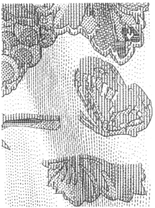
Damask (DAM-uhsk). Cloth with jacquard-woven floral or geometric designs, used for tablecloths, towels, bedspreads, and other household linens, as well as upholstery and drapes. Usually in white or one or two colors.
Denim. A sturdy, twill-weave cotton used for work and play clothes, blue jeans. Often has blue (indigo-dyed) warp and white filling threads.
Diaper. A woven pattern that shows repeated units of design that are all connected to one another or cover the whole surface of the cloth.
Dimity (DIM-i-tee). A thin, sheer, plain-weave cotton, with cords in the warp, often in stripe or check. Used for dresses, aprons, bedspreads.
Dobby. Any fabric woven on a dobby loom. These fabrics have small woven-in geometric figures such as bird’s-eyes, diamonds, and so forth. See illustrations on page 281.
Doeskin. Fine quality, smooth finish, satin-weave wool fabric with a slight nap, or similar napped fabric of other fibers. Used for coats, pants, uniforms.
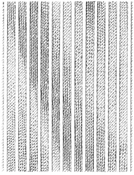
Donegal tweed (DON-i-gall). Woolen tweed of medium to heavy weight, originally handwoven in the county of Donegal, Ireland, but now any Irish tweed. In a plain or twill weave with a single color in the warp and a mix of colors in the filling yarns. Used for suits and coats.
Dotted swiss. Any fabric with dots created by swivel weave, lappet weave, or flocking. It is usually crisp, with a lawnlike background. Used for summer clothes, children’s wear, curtains.
Double cloth. Fabric with two layers joined in weaving. Used for overcoats, sweaters, blankets, upholstery.
Drill. A durable, closely woven, medium-weight cotton twill used for khaki and ticking.
Duck. A closely woven, durable, heavy cotton plain-weave fabric. Used for belts, bags, tents, awnings, sails. Also called canvas, but usually lighter than canvas.
Duvetyn (DYU-vuh-teen or duv-TEEN). A very softly napped, drapable fabric that looks suedelike or like a compact velvet.
Faille (file). Somewhat shiny, closely woven silk, cotton, rayon, or synthetic fiber fabric with a flat, crosswise, fine ribbed surface, similar to grosgrain. Used for dresses, suits, coats.
Filament. A fiber of indefinite length or of very great length. Filament yarn is made of one or more filament fibers gathered together.
Flannel. Napped plain-weave or twill cloth originally of wool, now usually of cotton.
Flannelette. A lightweight cotton flannel, often used for nightwear or baby clothes.
Fleece. A heavyweight, bulky woolen fabric with a long, fleecy nap, used for coats.
Fleur-de-lis (flure-d’LEE or flurr-d’LEE). Floral design resembling an iris.
Foulard (foo-LARD). Lightweight, plain-woven or twill silk or rayon fabric, soft, usually printed in small figures. Popular for neckwear, soft dresses, blouses, robes.
Frosting. Change in, especially lightening of, fabric color as a result of abrasion or rubbing.
Full-fashioned knit. A garment made from pieces that have each been knitted to a given shape. Such garments usually have a better fit.
Gabardine (GAB’r-deen). Sturdy, firm, clear-finished fabric in twill weave, with steep diagonal lines on the face of the cloth. Made of worsted, cotton, and other fibers. Used in suits, coats, sportswear.
Georgette. Thin, lightweight, crinkly silk fabric with a pebbly crêpe surface as a result of its hard-twisted yarns. The fabric has stiffness and body despite its light weight. Sometimes made of synthetics. Used for dresses, blouses, gowns, hats.
Gingham (GING’m). A plain-weave, medium-weight cotton fabric with a check (sometimes plaid or striped) design. Varies from coarse to fine, light fabrics. Commonly used in summer dresses and play clothes.
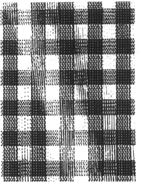
Greige (grazhe, rhymes with “beige”) or gray goods. Undyed, unfinished fabrics.
Grenadine. Open-weave dress fabric made of silk or synthetic fibers.
Grosgrain (GRO-grane). Closely woven, ribbed fabric with heavier crosswise ribs than poplin. Familiar in ribbons. Made in silk, cotton, rayon, polyester.
Hand. The tactile qualities of fabrics, or those perceived by touching, squeezing, or rubbing them with one’s fingers.
Herringbone. A twill with rows of alternating left- and right-hand twill lines. Usually seen in coats, jackets, wool dresses. (See illustration on page 279.)
Holland. Plain-weave linen or cotton, heavily sized and sometimes glazed. Used for window shades. (Formerly referred to a fine, plain-weave linen shirting fabric, especially from Holland.)
Homespun. Cloth woven at home rather than a factory. Or any loosely woven, fairly heavy plain weave, with coarse, uneven yarns, which looks hand-loomed.
Honeycomb. A dobby-woven fabric with a textured pattern of raised squares or diamonds that look like a honeycomb. Also called waffle cloth. Used for clothes and furnishings.
Hopsacking. Actually burlap, but the term also refers to any coarse, rough cloth in a basket weave or other weave with a similar look. Used primarily for sportswear, suits and coats, draperies.
Houndstooth check. A variant of the twill weave in which yarns of two different colors produce a jagged check effect.
Huck towel. A towel in a dobby weave, usually woven with borders or names, in color, such as the sort of towel you see at hotels or clubs.
Huckaback. Cotton or linen toweling in bird’s-eye or honeycomb dobby weave, or with a rough, pebbly surface, and with loosely twisted filling yarns or long floats to increase absorbency. See Huck towel.
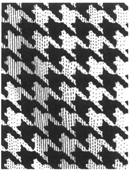
Hydrophilic. Tending to attract water; absorbent (of water).
Hydrophobic. Tending to repel water; unabsorbent (of water).
Irish tweed. Tweed made in Ireland, usually with white warp and colored filling yarns.
Jacquard (JACK-ard). Any fabric woven on a jacquard loom. The jacquard loom creates intricate designs woven into the cloth by means of punched cards that enable it to handle far more threads than other looms. Brocades, damasks, and tapestries are all types of jacquard fabrics.
Jersey. A smooth, plain-knit fabric of wool, cotton, rayon, or synthetic blends. Used for dresses, shirts, sportswear, underwear. Called stockinet in handknitting. See illustration on page 283.
Lace. An open-network fabric of twisted, looped, or knotted threads, usually forming intricate patterns.
Lamé (la-MAY). Any fabric with metallic threads woven in for decorative purposes.
Lawn. Fine, sheer, crisp-finished cotton or linen of plain weave. Less crisp than organdy or voile. Used for children’s clothes, summer dresses, sleepwear. See “Cambric.”
Madras. Cotton from the Madras region in India, either in natural color or vegetable dyed, often in colored plaids, stripes, or checks. Its tendency to fade and bleed as a result of the dyes used is periodically the object of faddish admiration.
Marled. Made of yarns of two different colors twisted together.
Marquisette (mar-ki-ZETT). Leno-weave open-mesh fabric, very light in weight, of cotton, silk, or synthetics. Used for curtains, dressy evening fashion. See illustration on page 280.
Matelassé (mat-el-lass-AY or mat-luh-SAY). Double-cloth woven on a jacquard loom to create a quilted or stitched surface. Used for bedspreads and draperies. Originally made of padded silk.
Melton. A dull, smooth, heavy, very short napped, quite durable wool fabric used for coatings and outerwear. Looks somewhat like felt. Also comes in fibers other than wool.
Mohair. Fibers from the hair of the angora goat, or a soft, woolen fabric made from mohair, in plain or twill weaves.
Moiré (mwah-RAY or mah-RAY). Any fabric with a wavy, watermarked design. Taffeta fabrics often receive a moiré finish, and some plain-weave fabrics are printed with the design.
Moleskin. A napped cotton fabric with a suedelike hand. It is made in a strong, heavy weave of coarse, carded yarn. Used for sportswear and work clothes.
Monk’s cloth. Loosely woven, heavy basket weave cotton, usually in brownish or oatmeal colors. Often used for upholstery, drapes, or other furnishings.
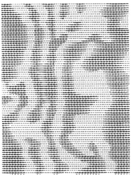
Mousseline (moose-uh-LEEN). The French term for muslin; refers to a finer fabric than our own cotton muslin. Used in the United States, it denotes any of several lightweight, sheer, crisp fabrics of a variety of fibers. “Mousseline de soie”—literally, “silk muslin”—is a lightweight, plain-weave, sheer, crisp silk or rayon that resembles chiffon. It is used primarily for evening wear.
Muslin. Originally a substantial plain-weave cotton, fairly strong and heavy. Now also refers to similar fabrics made from blends of cotton and other fibers. It exists in various weights and qualities and has highly varied uses, from heavy sacking to light dresses.
Nainsook (NANE-sook, rhymes with “look”). Plain-weave, soft, lightweight cotton fabric of varying grades, usually dyed in pastels. Made from the same gray goods that are turned into batiste and cambric. Used for ladies’ blouses and babies’ clothes.
Net or netting. Any fabric made of threads, string, or twine worked into open mesh. Of any fiber.
Organdy. A sheer, stiff, transparent plain-weave cotton, treated to make it permanently stiff.
Organza. Thin, transparent, stiff fabric of rayon or silk, used for evening wear.
Ottoman (OTT-uh-muhn). A crosswise-ribbed fabric similar to faille or bengaline but with heavier ribs. Wool, cotton, silk, or synthetic fibers may be used.
Oxford cloth. A plain- or basket-weave cotton, used for shirting. Usually has a double-yarn warp and a single filling thread. Oxford chambray is oxford cloth with colored warp and white filling yarns.
Paisley. Any fabric printed with a traditional paisley design. The paisley design, which originated in Paisley, Scotland, has a teardrop shape with a curving point.
Peau de soie (po-d’SWAH). Literally “skin of silk,” denotes a soft, good-quality silk (or silky synthetic) satin cloth with a dull surface. Used for dresses.
Percale (purr-KAL, rhymes with “Al”). A closely woven, plain-weave cotton, used for dresses, blouses, sheets. Percale has a thread count (fabric count) of 180 or higher.
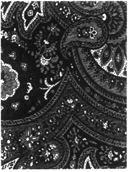
Pile fabric. Any fabric in which one set of yarns (pile yarns) stand vertical to the base fabric. May be made by weaving, knitting, and tufting. May have a looped or velvety surface. Examples are terry-cloth, velvet, velveteen, and corduroy.
Piqué (peek-AY or pik-AY). Any woven or knitted fabric with a raised pattern or quilted-looking surface. Usually of cotton; sometimes of synthetics. Woven piqués are usually medium- or heavyweight, rather stiff fabrics with raised crosswise cords, often used for collars, cuffs, dresses.
Plissé (pliss-AY). Has a puckered or blistered surface appearance in stripes created by a chemical treatment. In cheap goods, it may wash out. Looks like seersucker.
Pointelle. Any ribbed knit with tiny holes or openings in a pattern. Polished cotton. A plain-weave cotton with a glazed finish.
Pongee (pahn-GEE). Raw silk fabric often in a natural tan color, with a rather uneven, crude texture. The term is also used to refer to cotton or rayon cloth of a similar weight and texture.
Poplin. Plain-weave dress goods in which the filling is heavier than the warp, producing a fine, crosswise rib surface appearance. Most commonly a medium- or heavyweight cotton fabric, but also in wool, silk, synthetics.
Ragg. Formerly a fabric made from waste clippings of wool or used wool. Now may refer to new wool fabrics or garments made with multicolored yarns or made to resemble rough fabrics or garments of waste, used, or recycled wool.
Rep. Fabric with narrow, lengthwise ribs made with unbalanced plain weave.
Resilience. Ability of a fabric to spring back to its original state after being crushed or wrinkled.
Rib or ribbed fabric. Any woven fabric with a cord or ridge either lengthwise or crosswise, such as poplin, grosgrain, and rep. Any knit fabrics with lengthwise ribs on both sides.
Sailcloth. Strong, durable fabric of linen, cotton, jute, or nylon or other synthetics. Used for sails, play clothes, upholstery.
Sateen. A cotton fabric in a lustrous satin weave with filling yarn floats.
Satin. Originally referred to silk fiber in a satin weave, but now may refer to man-made fibers in a satin weave too. Highly lustrous, slippery. Used for evening wear, lingerie, linings. Any fabric made in a satin weave.
Seersucker. A dull-surfaced, medium-weight fabric with crinkly rows woven in. A variation of a plain weave. It is used for summer clothes. Classically of cotton fiber, but now made from synthetic fibers too.
Selvage. The edges of cloth that are finished in a tighter weave, sometimes with a different weave or heavier threads, to prevent their raveling. (Note, however, that some modern-weave selvages do not look this way anymore.) Sheets usually have selvages along the sides, with hems at the foot and head.
Serge (surj). Smooth twill made from heavy worsted yarns, clear finished.
Shantung (shan-TUHNG). Rough silk in plain weave with irregular filling yarns that give it a slubbed or textured effect; originally of wild silk. Sometimes refers to similar-looking fabrics in fibers other than silk.
Sharkskin. Medium- to heavyweight sleek fabric with slightly lustrous surface. Usually in a basket weave, of wool, rayon, silk, or synthetic fibers. Used for tailored suits, slacks, and sportswear.
Sheeting. Fabric of size, construction, and weight suitable for bedsheets.
Slub. A thick place in yarn caused by uneven twisting or irregularities in the fibers. Sometimes slubs are intentionally created for a fashion effect. Otherwise they constitute a flaw.
Staple. Fibers of medium or short length. Used to make spun yarns.

Suede cloth. A plain-weave fabric napped on one side. Made of cotton or other fibers.
Suiting. Any fabric suitable for coats or suits.
Surah (SORE-uh). Lustrous twill weave of silk, rayon, or synthetic fibers suitable for soft-tailored garments and neckwear. Available in solids, prints, plaids.
Taffeta (TAFF-et-uh). Any of a group of fabrics, all plain weave, fine, smooth, and crisp, usually with a fine crosswise rib. Originally of silk, now of almost any fiber.
Tattersall. A style of English plaid; usually has crossing lines in two colors forming squares on the background of a third color.
Tear strength. Ability of fabric to resist tearing.
Terry-cloth. Cotton-pile woven or knitted fabric with uncut loops on one or both sides.
Ticking. A type of drill cloth with alternate stripes of white and colored yarn. Used mainly for mattress, upholstery, and pillow covers. Term may be used to refer to any strong, durable, closely woven fabric used for such purposes.
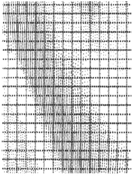
Toile (twhal). The term means, simply, cloth or fabric, or more particularly a linen cloth. It has come to be associated with “toile de Jouy,” which are printed linens made in Jouy, France.
Tricot (TREE-koh). A fine-waled warp-knit fabric, often used for underwear, sleep wear, and gloves. Of cotton or synthetic fibers.
Tulle (tool). Fine, soft, sheer silk (or silky synthetic) net fabric, usually with tiny hexagonal mesh. Used for veils, gowns, bridal gowns, dance costumes.
Tussah (TUHSS-uh). A sturdy, rough or coarse, loosely woven silk fabric, especially fabric made from Tussah silkworm (wild silk) fibers.
Tweed. Any rough-surfaced woolly fabric, usually woven in two or more colors, either plain or patterned. Originally a rough homespun fabric of heavy woolen yarns, today almost any fabric that is nubby and rough with mixed colors. Now of wool or almost any other fiber.
Twist. The number of twists or turns per inch given a thread or yarn. Hard-twisted yarns have many twists, soft-twisted yarns few. But in Beatrix Potter’s Tailor of Gloucester, the cry “No more twist!” refers to a specific kind of firmly twisted thread, the “buttonhole twist” that is needed to make the last of the twenty-one buttonholes in the mayor’s new waistcoat.
Union cloth. A fabric with cotton warp and filling of reused wool, usually heavily napped. Used for heavy overcoating.
Union linen. A fabric with cotton warp and linen filling. Sometimes this is called union cloth.
Velour. Thick, soft woven or knitted fabric with a deep pile (deeper than velvet). Mainly used as a suit or coat fabric.
Velvet. Fabric with short, thick, smooth pile. Originally of silk, now of many types of fiber.
Velveteen. A cotton velvet. It has a short, thick pile and a dull surface.
Voile (voil, rhymes with “oil”; or vwahl). Plain-weave, lightweight, sheer, crisp fabric made of hard-twisted spun yarns, loosely woven. Used for dresses, blouses, and curtains. Of cotton, silk, rayon, worsted.
Waffle cloth. Any fabric woven on a dobby loom in a wafflelike pattern, such as honeycomb or waffle weave.
Waffle knit. Knit fabric with a pattern of wafflelike squares.
Waffle weave. See “Waffle cloth.”
Whipcord. A fabric made from worsted. Similar to gabardine but with a steeper twill. Has a hard, wiry hand. Used for riding clothes and other highly tailored garments. Now may be seen in many fibers other than wool.
Zibeline (ZIB-uh-leen). A woolen coating fabric with a long, lustrous, hairy nap of straight fibers laid in one direction.
* Only about 50 percent of raw wool by weight is in fact fibrous material. The rest is oils or fats, excrement, dirt, and other matter, which all goes into the sludge. From this unsavory potpourri lanolin is extracted and subsequently used in the manufacture of such items as peppermint cremes and lipsticks.
* Despite hopes that a new (2002) Department of Agriculture National Organic Program would promote an increase in organic cotton farming, these figures represent a significant decline in United States organic cotton production. At the same time, however, United States and worldwide demand for organic cotton fabrics is increasing, and organic cotton production in other countries outstrips ours.